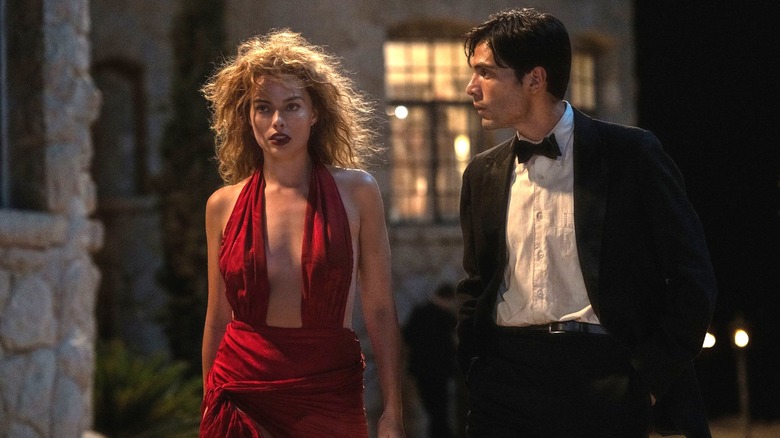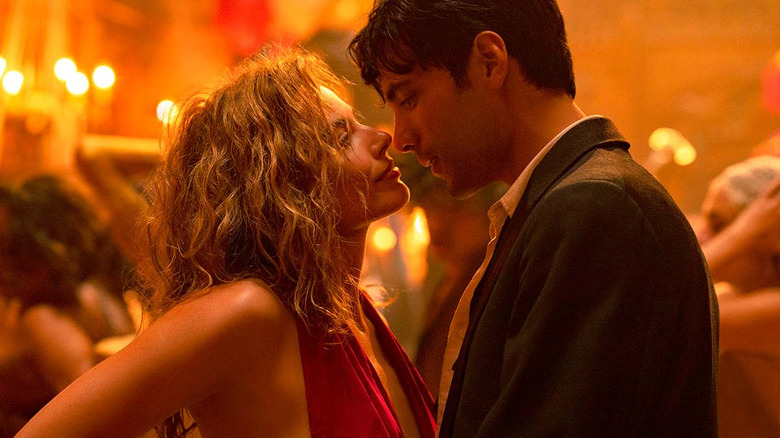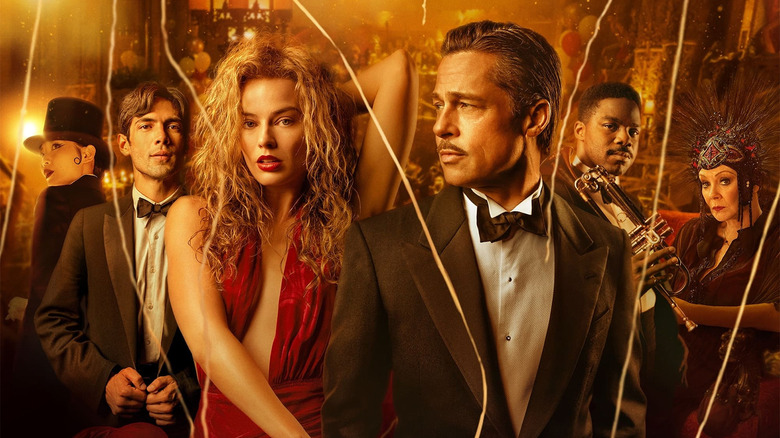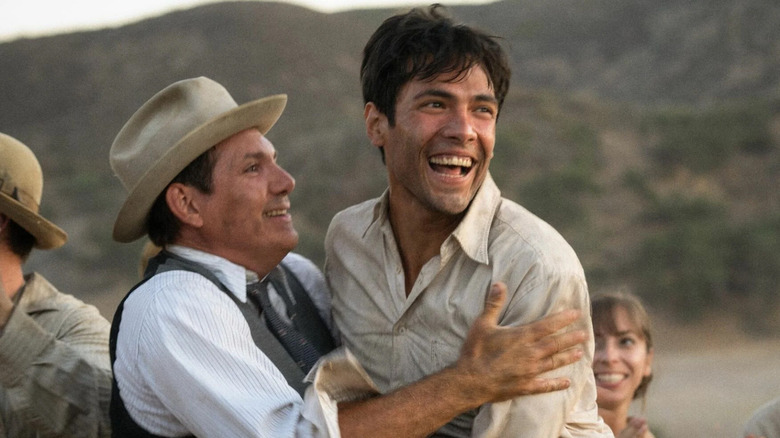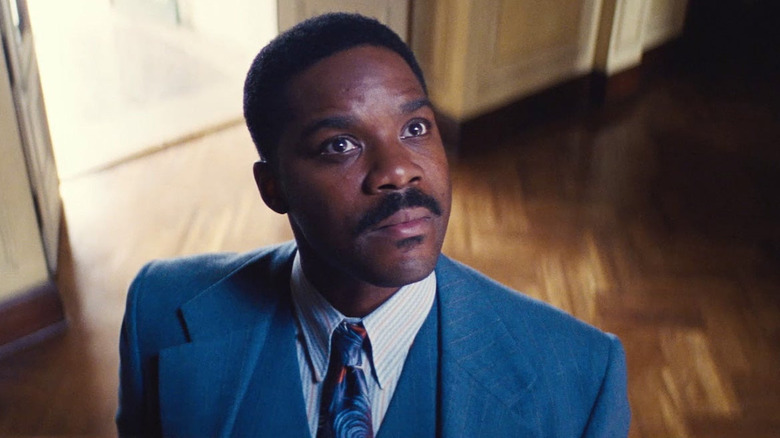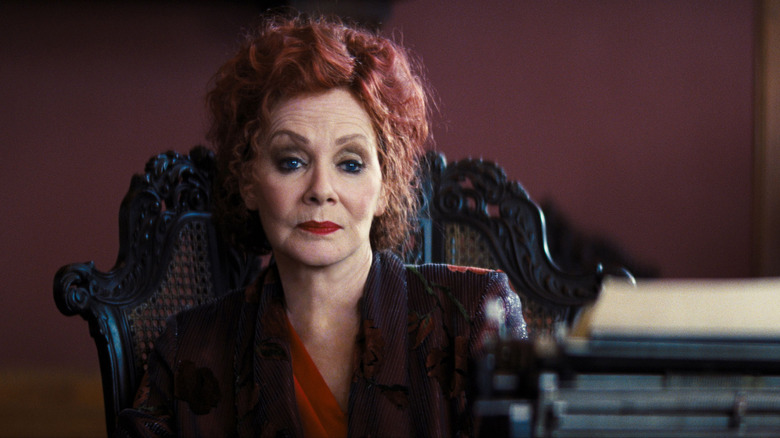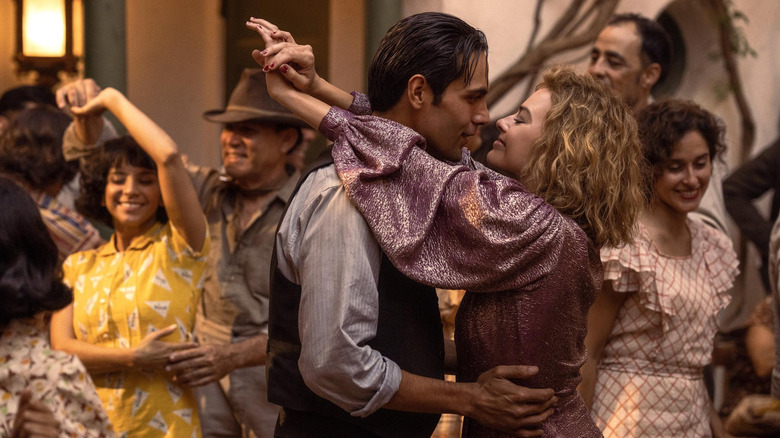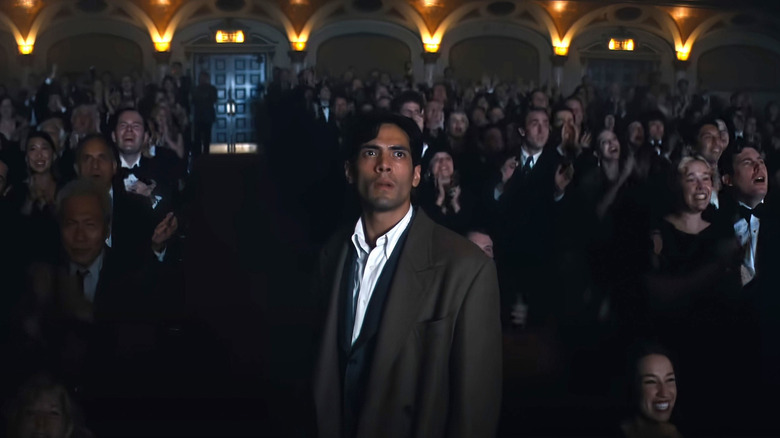Damien Chazelle's Babylon Is A Story Of Identity And Assimilation Amid Hollywood Chaos
It's unsurprising how many have compared "Babylon," director Damien Chazzelle's super-charged elegy for early Hollywood, to "Boogie Nights" and "Singin' in the Rain." In its tensions — talent and luck, apocryphal myth-making and the lesser-known truths, moral incongruity and creative spunk, and the critique of an apathetic business that nonetheless creates empathetic works — Chazelle's "Babylon" bears some lineage to both films.
If you only focus on those influences, however, you will miss the primary tension: The fight between identity and assimilation. These politics, as viewed through the film's protagonist, Manuel Torres (Diego Calva), position Chazelle's behemoth vision closer to "The Last Black Man in San Francisco," "Medicine for Melancholy," and "Bamboozled" as an assimilation narrative affixed to a fable.
In Joe Talbot's "The Last Black Man in San Francisco," amid a gentrifying city selling the remnants of its Black heritage to the highest bidder, Jimmie Fails (played by Jimmie Fails) desperately clings to the house his grandfather supposedly built. In Barry Jenkins' "Medicine for Melancholy," after a one-night stand, Jo and Micah, two young Black folks, spend the day together walking across San Francisco to spots reminding them of their racial and cultural betweenness in a city rapidly gentrifying to tech yuppies. Spike Lee's "Bamboozled" takes notice of a Black television executive designing his escape from his overtly white surroundings by creating a Black-faced minstrel variety show he's sure will fail big enough to instigate his firing.
Of course, unlike those works, "Babylon," a well-researched narrative which follows a quintet of performers navigating the debaucherous landscape of Hollywood, isn't a Black-centered film. But its interest in the past and Los Angeles' historiography — an elusive fusing of Kevin Brownlow's "The Parade's Gone By..." and Kenneth Anger's "Hollywood Babylon" — as a white capitalistic crucible wearing down the desires and identities of people of color is strikingly similar.
Manuel's romantic fantasy
"Babylon" takes place in 1920s Hollywood, toward the tail end of the silent films and the dawning of talkies, when some of the greatest creative lights were women and people of color. But in that history, in a movie intrigued by legend rendered as history and history rendered as legend, not to mention Hollywood's self-sanitation of its past, there is a fascinating playground to consider how Tinseltown forced some to assimilate, manipulating their cultural and racial identities for mainstream entertainment, or merely be erased.
In Chazelle's epic, we focus on the forced assimilation of Manuel, a Mexican-American Hollywood gofer who rises from fixer to being the personal assistant to matinee idol Jack Conrad (Brad Pitt) and eventually a studio executive. In the process, Manuel cuts off ties with his Mexican roots — though they live in Los Angeles, he never visits his family — he Americanizes his name to Manny, and at a party thrown by William Randolph Hearst, he presents himself as a Spaniard. Manuel becomes intoxicated by his proximity to the white capitalistic greed that governs Hollywood (and partly the American dream of upward mobility), causing him to traverse a tenuous betweenness of identity.
The erasure of his identity is sparked by a romance, not just the loving kind, but the fantastical kind. And it begins with an elephant, which s**ts across the opening frames, as the on-the-nose fulcrum of this bleak fairytale. Manuel first appears while transporting this mammoth up an incline to a coke-filled hilltop mansion housing an orgy thrown by studio head Don Wallach. Upon entering the party, cinematographer Linus Sandgren renders the lens an outsider, its gaze darting almost chaotically across the room, focusing on sex happening here, there, and everywhere. A crimson swirl of debauchery, soundtracked to composer Justin Hurwitz's rhythmically commanding earworm score, sets a scene that holds noise and truth in equal value.
Assimilation recodified
On the margins, in other rooms, nuanced arcs are established. A young starlet recalling Virginia Rappe overdoses after indulging in the paraphilic infantilist kink of a character inspired by Fatty Arbuckle. The womanzing Conrad (Brad Pitt) hides seemingly in a debonair cocoon outside of the party's hedonistic milieu; a talented Black trumpeter named Sidney Palmer (Jovan Adepo), playing unrecognized to the wider partygoers, provides the proceedings' energetic spark; the seductive Lady Fay (Li Jun Li), a Chinese-American actress and inter-title writer by day, takes the exotic spotlight by night as a queer cabaret singer. And gossip columnist Elinor St. John (Jean Smart) peruses the wild party for her next scoop.
In another room, in the background to this rapturously bombastic scene, Manuel and party-crashing star-to-be Nellie LaRoy (Margot Robbie), a lightning bolt of energy and will, pontificate on the enduring possibilities movies contain. Within Nellie, Manuel locates his love for what Hollywood seemingly represents: An indefinable magical quality, upward mobility, picturesque happiness, and the ability to permanently define yourself. It's no mistake that Nellie is the first to call Manuel, "Manny."
Manuel's idolization of Nellie, in a different context, recalls the observation Michael Boyce Gillespie makes in "Film Blackness" about Micah's interest in Jo in "Medicine for Melancholy." Gillespie writes:
"With urgency of a dying language, he appears to be pushed to court her for what he wants her to be but not for who she is. Crucially his nostalgia does not recognize that the past that preoccupies and drives him also represents a self that no longer exists."
In this case, the "self" is not the unchanging stasis of Black identity, but the utopian idea of Hollywood as a dreamland rising above its manifest destiny origins, which is not uncommon to America's bait-and-switch — assimilation recodified as the melting pot, exploitation renamed as the land of opportunity — sprung upon the unsuspecting marginalized.
The orgy becomes the site where Chazelle's bleak comedy, his interest in Hollywood myth, the subversion of the fable — a breaking of the illusion — takes place. The Arbuckle character is spat on and demeaned. LaRoy dancing upon a table is chosen at random to take the overdosed actress' part in a movie. Manuel is asked to dispose of the overdose actress by way of literally inserting an elephant into the room. While partygoers watch this mammoth smash their revelry, they miss the sanitation of a body being disposed of. It's telling that after the scene, we never hear from the actress again, and we only see the Arbuckle-inspired character once more in a sea of performers filming their trade on a studio lot (in the Hollywood ecosystem, both are disposable, one sooner than the other).
Real truths in a gruesome package
Fables are often used to package hard truths in easily digestible packages, thereby providing a cogent lesson to the viewer through plaintive metaphors (the script partly accomplishes this by using history, amalgams of real figures like Clara Bow, John Gilbert, Anna May Wong, and so forth, as a starting point for this alternative-narrative). Like a Brothers Grimm fable, Chazelle also gives us real truths in a gruesome package. If you leave "Babylon" disgusted, that's the point. You should be disgusted with Hollywood. No one wants to be that actress, or Arbuckle, for that matter — insulted and rendered disposable. In this anti-fairytale, they placate to the fear, planted by an apathetic system, to assimilate to the dominant culture, with the hope they can withstand the possibility of burning out or being discarded. We witness the imperative choices burdening people of color primarily through the eyes of Manuel.
He contributes to the mythology: In one scene, he retrieves a camera for a large set piece. Unnecessary death has occurred, Conrad is near-puking from his drunkenness, and the director (played by filmmaker Spike Jonze) is at a loss. But once Manuel appears with the camera, the scene is shot — an Edenic sunset and perfect kiss occur in an unbelievable composition — and the anticipated movie audience is none the wiser to the destruction behind the art.
Others also contribute to the myth building: Nellie is filmed by a Dorothy Arzner-inspired director, a trio of Black musicians play the accompanying music, Lady Fay, while writing inter-titles, dubs Nellie "The Wild Child," and Jean Smart wraps Nellie's work in rapturous words.
It's the kind of creative spirit that Chazelle clearly loves about Hollywood. And the industry is initially welcoming of this quintet's unconscious collaborative spirit: Their unique talents makes each indispensable to the star-making, box office hit-crafting process. They become all the more necessary when two changes happen. The introduction of sound with "The Jazz Singer" disrupts the order of Hollywood: White performers like Conrad and Nellie are forced to adapt, though Sidney, by way of his trumpet-playing and luck, moves from the periphery to becoming a star of jazz shorts. Meanwhile, Manuel becomes a studio head. The enactment of the Hays Code, however, limits the opportunities Manuel and Sidney believe they've gained.
There's more to Babylon's parties than meets the eye
You can, in fact, chronicle the assimilation of characters through the toning down of the film's parties and costumes and hair. The red swirling hedonistic ball becomes a swank yet rambunctious pool party. That in turn becomes a buttoned-up meet and greet, where perversion doesn't exist in plain sight but it can be seen in the not-so-subtle way a "sophisticated" businessman squeezes a woman's rear end. The quartet collide: Conrad discovers he's fallen out of favor with producer Irving Thalberg, the white party guests (who would've voted for Obama a third time if he weren't a distant glimmer) ask a tokenized Sidney about racial progress, Nellie appears with a bob cut instead of her red electric shock of hair, and most importantly, Manuel rebrands himself as the Spaniard Manny Torres, and he shows up with a white woman on his arm.
The further Manuel travels up the ladder, the more he sands away his Mexican identity, and the greater he becomes a tool for assimilation: To tone down Nellie's wild child image, for instance, he banishes Lady Fay, rumored to be in a queer relationship with Nellie, away from the studio lot.
In another scene recalling Lee's "Bamboozled," Manny asks Sidney to don Blackface makeup so he might be dark enough for this jazz short to play in the South. Manny is no longer a disheveled gofer; his hair is slicked back and his face is nearly gaunt. Chazelle lights Calva in a greedy green hue, rendering his cheekbones with a sinister flair, as Manny guilts Sidney into wearing the makeup by saying if he doesn't, the band will lose their jobs. Sidney acquiesces. The actors throw gut punches; when Manny turns his back to Sidney, Calva allows a pang of remorse, knowing he just betrayed a fellow person of color for crumbs to appear across his face. In tears, Adevo blares his horn toward the edge of unhinged sorrow. It's the nuance by these two performers that elucidates the journey toward the soul-crushing capitalistic middle, which bows toward othering, in one of the film's most heartbreaking scenes.
In Manny killing the illusion of community action, he murders the dream. And similar to "The Last Black Man in San Francisco," once the illusion dies, the dreamer must decide whether to hold onto the fantasy or depart the city they love. For Fails, that specter evaporates when he admits that his grandfather did not build that home. For the characters in "Babylon," the realization happens with Manny's betrayal: Realizing the self-destructive price of being tokenized, Sidney leaves his studio contract for the Chitlin' circuit, and Lady Fay heads to Europe. Though their arcs could be accused of being too truncated, the emotional weight of these scenes still hold: Because they remain true to themselves rather than contorting to fit a bigoted, assimilative mold, they are granted happier endings whereby their creative spirit remains intact.
The bleakness of Hollywood
Chazelle brilliantly juxtaposes these people of color from their white counterparts, primarily Conrad. In a bid to recapture his matinee idol glory, Conrad attempts to remake himself for the talkie era. His efforts go for naught; audiences laugh at his new movies. In a meeting with St. John, she explains to a dejected Conrad his tactical error: He believed Hollywood needed him. But it doesn't. Unlike the "cockroaches," who know when to leave the burning building, understanding that the building will burn without them, he decides to remain.
It's a bleak, melancholic monologue sharply delivered by Smart that recalls how Gillespie explains gentrification in "Medicine for Melancholy." Gillespie wrote:
"This new class partakes in the accrued cool of spaces and cultures whose histories are refabulated in the revisionist terms of capitalism and obsolescence. Ultimately locals are revised and coded as outsiders and space invaders in a public attuned to newly arriving and ordained outsiders."
Lady Fay and Sidney see how they've been coded and escape. Conrad cannot bear the truth and dies by suicide. Manny fully embraces his new coding.
Though Manny was elevated to executive to build out Spanish-language programming, tellingly, we see very little of Manny pulling others along. He is the only one in the room, and he exists comfortably with that fact. Only Nellie receives his lone shred of loyalty, because Nellie's whiteness represents the spark of self-mythmaking that drew Manny to Hollywood. In Manny's recovery of his past with Nellie, he attempts to solidify his identity. Every time Manny sees Nellie, he is reminded of the party where they met. And from this past, he sees a future. Even when Nellie appears at his doorstep, begging for money to repay to gambling debt, he desperately holds onto this promise.
Babylon is a fable
At its heart, however, "Babylon" is a fable. And the best fantasies burst when the protagonist realizes the hollowness behind the candy-coated dream. Fascinatingly, this occurs when The Count (Rory Scovel), a whimsical yet aloof drug pusher, somehow procures cash in record time to pay off a gangster presently hunting Nellie. Manny, of course, eventually learns that it's prop money. This white character doesn't see a problem: Because in Hollywood, everything is fake, from someone's persona to the money. So to sell your soul to the capitalist machine is to give away your integrity to an imaginary concept. Manny and The Count encounter the same blurred lines at another site where gruesome comedy and bleak disgust collide, when they're led by the gangster to an occult subterranean party whereby a geek eats a live rat and is treated like a star. What's the difference between stardom and a freak show? Between Nellie or Conrad or the geek? In the eyes of Hollywood, they're one and the same — expendable fits of entertainment.
In the final scenes of "Babylon," Chazelle uses Manny and Nellie's romance to demonstrate their betweenness. After Manny and The Count escape from that sinister party, while searching for a gas station, Manny and Nellie stumble upon a party (we're meant to assume the merrymakers in the celebration are Mexican). Similar to the club scene featuring Micah and Jo dancing amid a sea of white hipsters in "Medicine for Melancholy," it's the first place where the pair are a couple. In each other's arms, swaying to the music, they become inebriated with a future that involves them marrying and absconding to Mexico. And yet, like Micah and Jo, this sequence can not paper over the political differences Manny and Nellie represent.
Plans change when they depart the party, because Nellie can never truly leave Los Angeles. She is too intertwined with its whiteness to seek a life away from self-sanitizing streets of Tinseltown. Manny, however, is a survivor. In a shabby apartment, a bloodied Manny begs for his life in the face of a gunman. The contract killer allows him to leave if he promises to escape Hollywood and never come back. Like the ending to "The Last Black Man in San Francisco," when a dejected yet unbowed Fails rows away, Manny drives into darkness, toward freedom.
'You don't get to hate it if you don't love it'
It's no coincidence that when Manny returns to Los Angeles, decades later, he comes back with a Mexican family. Similar to Sidney, away from Hollywood, he returns to a racial homogeneity unallowable in a business demanding assimilation. With his family, Manny visits the studio he partly built. Alone, he wanders the streets of Hollywood, now clean and corporatized, but still just as unforgiving. He wanders into a theater's showing of "Singin' in the Rain." In the film, he remembers the tensions, brutality, and lost loves endured. He recalls his feelings for Nellie and is reduced to tears.
Romance also gives space for Chazelle to manipulate time by highlighting a singular moment, whereby the retrospective viewing of history offers Manny an opportunity for redemption. The final montage, which traces through nearly a century's worth of cinematic innovation that calls back to silent film and early Hollywood, also serves to recover a the idealism that a broken Manny left behind. In his "Cinema Paradiso" epiphany, as Hurwitz's horns clatter and a crashing crescendo reveals, Manny's tears of sorrow become drops of joy. He can remember the toil while cherishing the artistry on display.
Like "The Last Black Man in San Francisco" — when Fails says, "You don't get to hate it if you don't love it," to two white women bemoaning the city — Chazelle's rhapsodic "Babylon" is a film that understands revealing the tension in Hollywood's fable doesn't mean the dream will ever truly die.
"Babylon" is playing in theaters everywhere now.
